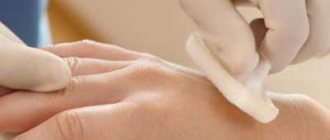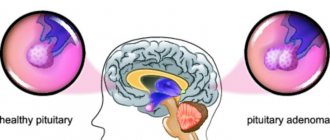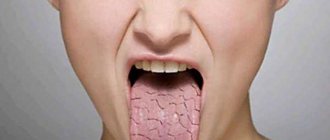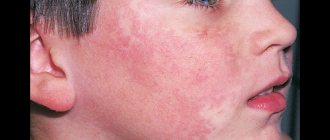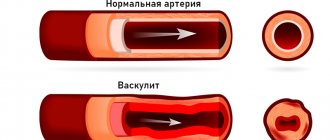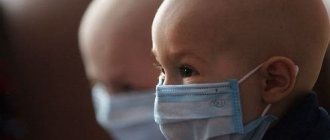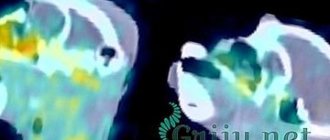Lyell's syndrome - main symptoms:
- Red spots on the skin
- Headache
- Skin rashes
- Weakness
- Fever
- Hair loss
- Drowsiness
- Disorientation
- Extreme thirst
- Pain syndrome
- Dehydration
- Skin erosions
- General swelling
- Blisters on the skin
- Skin soreness
- Peeling of affected skin areas
- Decreased sweating
- Fusion of skin spots
- Decreased salivation
- Nail loss
What is Lyell's syndrome
Lyell's syndrome is an allergic dermatitis in which bullous lesions of the skin and mucous membranes occur. In addition, the general condition of a person sharply deteriorates. Lyell's syndrome is also called pemphigus maligna or toxic epidermal necrolysis.
- Etiology
- Symptoms
- Diagnostics
- Treatment
- Possible complications
- Prognosis and prevention
ICD-10 code: L51.2. This syndrome most often develops in children and young adults. 0.3% of patients who are allergic to medications exhibit the main symptoms of this syndrome.
What causes this disease in a person?
The reason for the development of Lyell's syndrome lies in the immune reaction, which is not protective, but pathological, because it is directed against the body's own tissues. The antigen can be various microorganisms, as well as a chemical compound. In medicine, the following types of allergic reaction to the body are called, which can cause the development of the disease:
- Allergies to infections: staphylococcus, salmonella, tuberculosis, tularemia, brucellosis, herpes, hepatitis, mumps. Often such pathogens affect the child’s body, which is characterized by a particularly severe course.
- Allergy to medications. As a rule, an allergy occurs to a specific antibiotic, non-steroidal drug, aspirin, sulfonamide, anticonvulsant, glucocorticosteroid. This also includes a radiopaque contrast agent.
- Combined allergy, combining the effects of an infectious agent and medication on the body.
Quite often, the syndrome occurs in people who already have a certain allergic disease, for example, atopic dermatitis, eczema, bronchial asthma.
Causes of the disease
The causes of Lyell's syndrome are as follows:
- The use of various medications: anti-inflammatory drugs, antibiotics, analgesics, anticonvulsants, and many others. The syndrome develops when the active components of several drugs are found in the body or when a large dose of one drug is used.
- Infectious pathology, such as Staphylococcus aureus of the second group. This is a common cause of this syndrome in children. Its course is extremely unfavorable.
- The use of drugs against the background of infectious pathology.
In some cases, it is not possible to establish the reason why toxic epidermal sudden necrolysis occurred. Therefore, this condition is called idiopathic.
The main factor influencing the appearance of this syndrome is a genetic predisposition to allergies to certain medications. Many patients have already suffered from diseases associated with a violation of the mechanism of neutralization of various toxins.
Lyell's syndrome manifests itself in the following pathogenesis: an allergen (in this case, a medication) combines with proteins that affect the formation of skin cells. The body takes this new compound as an antigen and begins to eliminate it. This destroys the top layer of skin, as well as the mucous surface, and protein breakdown products, in other words, toxins, accumulate in the organs. Because of this, the functioning of internal organs is disrupted: the kidneys begin to fail, electrolyte and water balance are disrupted.
Mechanism of exotic reaction development
How does Lyell's syndrome manifest in children? The process of neutralizing metabolic products is disrupted in the body. Thus, the medicine combines with the protein that is part of the surface layers of the skin. As a result, a foreign substance is formed in the structure of the latter, to which an acute immune reaction follows.
Interestingly, all patients with both Lyell's and Johnson's syndromes are characterized by the presence in the body of immunological reactions known as the Schwartzman-Sanarelli phenomenon.
Symptoms of the disease
When Lyell's syndrome occurs, symptoms appear almost immediately.
At the same time, over the course of three days there is a sharp increase in them:
- First, body temperature increases to 40°C.
- After a few hours, red erythematous spots appear on the body. After a while they begin to merge with each other. Outwardly, it resembles scarlet fever or measles. The rash begins to appear on the face and then spreads throughout the body.
- Swelling and pain appear in the skin and mucous surface of the entire body. In children, Lyell's syndrome manifests itself on the mucous membrane of the eyes.
- After about a day, the rash begins to degenerate into blisters with a thin film. They can reach fifteen centimeters. A serous or serous-hemorrhagic substance forms inside. Bubble bursting occurs very easily. Erosion with hemorrhages occurs at this site. Crusts immediately form on the mucous membranes.
If a patient has Lyell's syndrome, then when you touch his healthy-looking skin, it begins to peel off. Beneath it, a constantly weeping surface with an inflammatory process is revealed. This phenomenon is called Nikolsky's symptom. In such a place, the patient’s skin is red and painful, the same as with a third degree burn. Some patients develop a small rash.
Rashes due to Lyell's syndrome.
In addition to these symptoms, there are also general signs of pathology:
- headache, weakness, drowsiness, disorientation;
- dehydration of the body, but the patient experiences extreme thirst, the blood begins to thicken, the production of saliva and sweat decreases;
- Nails and hair begin to fall out.
When the first signs indicating toxic epidermal developing necrolysis appear, you should consult a doctor.
Symptoms
Previously, Lyell's syndrome with an area of skin affected less than 10% was called Stevens-Johnson syndrome. It is currently considered a milder form of toxic epidermal necrolysis with a fatality rate of less than 5%. Both of these syndromes are characterized by involvement of the mucous membranes in the process (in more than 90% of cases of the disease). Forms with an area of skin damage from 10 to 30% are classified as intermediate.
Manifestation of Lyell's syndrome
In the clinical course of the disease, 3 periods are conventionally distinguished:
- Prodromal, which develops in the first 2 weeks after starting to take the corresponding drug (usually in the first 2-3 days). Sometimes this period is several hours and even (rarely) 1 hour.
- Critical, or acute.
- Recovery.
Usually the disease begins with a rapid increase in body temperature to 38-41°. The general condition suddenly becomes severe, severe chills, general weakness and malaise, headache, pain in the joints and muscles, lumbar region, pain when swallowing, enlarged peripheral lymph nodes, loss of appetite, and slight nasal congestion appear.
In addition to these signs, an inflammatory process of the mucous membrane of the oral cavity, nose, eyelids, conjunctiva, and genitals is often noted. Often the patient complains of a feeling of moderate pain, burning and itching of the skin.
Acute period
Erythematous
Resembles eruptive elements on the skin and mucous membranes of exudative erythema multiforme. The rash is represented by erythematous spots, roseola, papules, and pustules. A papular-erythematous rash is typical of the onset of the disease and is located symmetrically, appearing first on the face, then on the limbs and trunk.
Bullous
After 2-3 days, large, irregularly shaped, thin-walled blisters with a brownish tint and a flabby covering form in the center of the erythematous spots. Bubbles tend to merge. When pressed, their area can increase significantly, reaching even the area of the palmar surface of the hand (Asbo-Hansen symptom).
This stage is characterized by a burning sensation and itching of the skin, increased and impaired sensitivity of not only the affected, but also healthy areas of the body. In addition, there is such severe pain in the skin that even a light touch of the sheet causes it. Dehydration develops, accompanied by excruciating thirst.
Related articles: Bullous dermatitis
Desquamation
It is characterized by slight rupture of blisters with exposure of extensive erosive surfaces of cyanotic-red color with serous-hemorrhagic discharge. Erosions are sharply painful when touched and bleed easily. Very quickly, almost the entire skin surface takes on the appearance of a II-III degree burn. At this stage, sharply positive Nikolsky’s symptom and its variety of Asbo-Hansen’s symptom are noted, as well as symptoms of “wet underwear” (under the influence of a finger, the epidermal layer easily slides, shifts and wrinkles), and “socks and gloves”, when peeled off on the fingers and feet the epidermis retains their shape.
Nikolsky's sign consists of peeling of the epidermis in an area of apparently normal skin when sliding a finger over it with slight pressure, as well as peeling of the epidermis near the bladder when pulling on pieces of the covering of the bladder. In especially severe cases, detachment of the entire epidermis on the entire skin surface of the body is observed during finger rubbing. A petechial rash may appear.
More than 90% of patients have erosions on the mucous membranes. Multiple painful and easily bleeding erosions appear on the lips and oral mucosa. On the lips they are covered with bloody crusts and cracks, which makes eating much more difficult. Often there is damage to the mucous membranes of the eyes with the formation of erosive blepharitis, conjunctivitis and iridocyclitis, as well as the pharynx and esophagus, larynx, trachea and bronchi, urethra and bladder, and genitals. Typical complaints with damage to the mucous membranes are photophobia and pain in the urethra.
The duration of the critical period depends on the rate of spread of skin lesions and the involvement of internal organs in the process, the presence of concomitant chronic infections and diseases of internal organs, as well as on the effectiveness of treatment and the timeliness of its initiation. Under unfavorable conditions, the acute period lasts about 3-5 days and in 30-70% of cases ends in death.
Causes of death:
- pronounced disturbance of the acid-base state and water-electrolyte balance;
- significant hemodynamic and microcirculatory disorders;
- severe intoxication of the body;
- development of disseminated intravascular coagulation syndrome (thrombohemorrhagic syndrome);
- disorder, mainly of protein metabolism;
- loss of the barrier function of the skin, infection against this background and the development of sepsis;
- respiratory, renal, liver and heart failure.
Recovery
Its duration depends on the same (listed above) factors. It is characterized by the cessation of detachment of the epidermal layer and re-epithelialization of the affected areas.
Lightning fast
Or hyperacute, which accounts for up to 10% of all cases of the disease. The cause is medication or idiopathic. Within 1 day, up to 90% of the entire skin surface is affected. Acute renal failure, impaired consciousness, and coma develop. Such patients very often arrive at the hospital in an extremely serious, terminal condition or do not survive to hospitalization at all. Death occurs already on the 2nd – 3rd day from the onset of the disease and is 95%.
Spicy
Accounts for about 50-60% of all cases. The disease occurs in all stages, from rash to necrolysis. The affected surface area can reach 70%. The duration of the acute form is 7-20 days. From the 3rd – 4th day, symptoms of hepatic-renal, cardiovascular failure, as well as complications of an infectious nature of the lungs and genitourinary organs, are noted. Progression of the disease often leads to sepsis. Fatal outcome is observed in 60%.
Favorable
Or smoothed, the frequency of which in the total number of patients with Lyell's syndrome is on average 30%. The skin and mucous membranes are affected in no more than half of patients with a smoothed form. The disease reaches its highest manifestation on the 5th – 6th day, after which over the course of 3-6 weeks there is a gradual regression of symptoms and a complete restoration of health.
In addition, depending on the nature and extent of skin symptoms, the degree of involvement of the mucous membranes and internal organs, three variants of Lyell's syndrome are distinguished:
- atypical;
- with spots;
- without spots, which is a typical variant of toxic epidermal necrolysis.
Symptoms of Lyell's syndrome:
- For children, the first sign is the appearance of conjunctivitis (inflammation of the eye mucosa, redness);
- Detachment of the epidermis, blisters on the skin and mucous membranes of the body: eyes, lips, tongue, nose, genitals. Multiple inflammations manifest themselves in a runny nose (nasal mucosa) and cough (larynx mucosa). The general condition of the skin is comparable to a II–III degree burn;
- The phenomenon of “wet underwear”, when the skin wrinkles and hurts with each touch;
- Loss of keratin, that is, weakening and loss of hair and nails;
- Fever, temperature 39–41 C°;
- Dehydration: little saliva, sweat, urine; I'm thirsty. As a result, blood flow slows down - headaches, drowsiness, apathy, anuria (stopping the flow of urine into the bladder);
- Since the syndrome appears due to an allergy to medications, it can therefore occur against the background of diseases that are treated with them. In this case, their symptoms accompany Lyell's syndrome. For example, due to sepsis (blood poisoning), it can appear against the background of pulmonary edema, hemorrhages, and anemia.
- In the first prodromal period of the disease (from several hours to three days after taking the medicine), the patient feels malaise, chills, weakness, migraine, decreased appetite, thirst, the mucous membranes of the nose, mouth, and genitals become inflamed, a runny nose and cough begin. Often at this stage, this syndrome is diagnosed as an acute respiratory viral infection (ARVI).
- The second period is critical. Metabolism is disrupted, an erythematous rash, growths, pimples, and blisters appear. Within two days, the walls of the blisters become brown, thin and flabby. The skin itches, burns, even contact with the sheet causes pain. Then the blisters burst and bleed after any contact. During the critical period, the risk of death increases to 60%
- The third period is recovery. The skin stops exfoliating and returns to normal.
The disease progresses very quickly. If the patient goes through the first two stages in a couple of days, the situation is catastrophic, most likely the outcome will be fatal. If the course of the disease is smooth (about seven days) and there are no complications, the child is highly likely to recover.
Lyell's syndrome first of all manifests itself in the form of an increase in temperature to 39-40 degrees, and for no apparent reason. Then rashes begin to appear literally all over the body. They are reddish pimples that increase in size and swell over time.
After about two days, the patient's rashes are replaced by blisters, which can be quite impressive in size. The skin over them tears very easily. It is at this stage that Lyell's syndrome is diagnosed. Symptoms are generally similar to those of second degree burns.
Diagnostics
The syndrome is diagnosed on the basis of anamnesis, visual examination of the patient, as well as the results of laboratory tests.
They include:
- blood analysis;
- Analysis of urine;
- histological examination of exfoliated skin.
The doctor must determine the cause of the pathology, that is, find the allergen. But there is a difficulty in this: acute epidermal necrolysis may appear only a week after using the drug. To determine the exact cause, immunological tests are performed.
At the first stage of development of such a syndrome, a differential diagnosis is carried out, which will help to exclude scarlet fever and a phototoxic reaction. If the pathology is detected late, then it is necessary to exclude burns, erythroderma and Stevens-Johnson syndrome. Jones syndrome is similar to Lyell's syndrome, but is slightly different. First, the mucous surfaces of the mouth, eyes and genitals are affected, and then the skin of the hands and feet. The rash covers only 40% of the entire skin. The skin does not peel off.
What is the diagnosis based on?
No special instrumental diagnostics (ultrasound or MRI) are performed. The diagnosis of Lyell's syndrome is made based on the symptoms that the doctor sees. Also, for differentiation with some similar diseases, human laboratory tests are evaluated:
- in a general blood test:
- increased number of leukocytes (more than 10 * 10 9 /liter),
- no or few (0-1) eosinophils (this distinguishes Lyell's syndrome from other similar allergic diseases),
- there are fewer lymphocytes in the blood,
- there are young forms,
- increased number of rod forms
- blood contains toxic forms of neutrophils;
- in the proteinogram with this syndrome there is a decrease in the total protein level due to albumins, globulins, on the contrary, are increased;
- All liver test parameters are elevated;
- in “kidney” samples with Lyell’s syndrome, an increase in the level of urea and nitrogen is noted;
- the balance of electrolytes is disturbed: potassium, sodium, calcium, magnesium.
Treatment of the disease
It should be noted that treatment of Lyell's syndrome is carried out only in a hospital setting. The first emergency treatment for diagnosed Lyell's syndrome is to stop taking all medications. The patient could take them on the eve of the appearance of the first signs. In addition, the patient’s stomach is washed, enemas are given, diuretics are administered, and plenty of fluids are prescribed.
Subsequent treatment tactics are as follows:
- Use of intravenous corticosteroids. In this case, large doses are prescribed. When the person’s condition improves slightly, the dose is reduced and taken orally.
- The blood is cleansed of harmful substances.
- Saline solutions, Reopoliglucin and other agents are administered to help cope with dehydration.
- Local therapy is used. Aerosols are sprayed, wounds are treated with antiseptics, and wound-healing ointments are used. The mucous surface is generously watered with bactericidal agents.
Medicines are also used that restore the functioning of internal organs. In addition, they use: painkillers, antibiotics, blood thinners, antihistamines.
There are also modern methods of treating this syndrome. For example, hyperbaric oxygenation is often used - a procedure for saturating the patient’s body with oxygen. In this case, it is carried out using high pressure.
Possible complications
This pathology develops rapidly. The patient's condition, if he is not helped in time, quickly deteriorates.
The following consequences may occur:
- due to decreased immunity, the body’s protective reaction worsens - a viral, bacterial or fungal infection appears;
- pneumonia, pulmonary edema;
- inflammatory process in the kidneys, which can lead to tissue death;
- sudden deterioration of vision;
- bleeding in the stomach.
In addition to these, other, no less serious complications may appear.
Prognosis and prevention
The prognosis of such a syndrome depends on the stage of pathology at which complex treatment was started. If therapy was started in a timely manner, then progression can be stopped in about a week. After this, the patient completely recovers.
When the pathology develops quickly or the patient comes to the clinic late, then the prognosis is unfavorable.
It should be noted that the prevention of Lyell's syndrome consists of using medications only as prescribed by a doctor.
If you need to change the drug, then you need to consult a doctor. You cannot use several products at the same time, especially more than five.
These recommendations must be followed by allergy sufferers. But if any symptoms of this pathology begin to appear, you must stop taking the medications and consult a doctor. It should be understood that timely initiation of therapeutic measures and careful attitude towards one’s health significantly increase the chances of a full recovery and eliminate the development of complications.
What to do?
If you think you have Lyell's Syndrome
and the symptoms characteristic of this disease, then doctors can help you: a dermatologist, a therapist, a pediatrician.
Diseases with similar symptoms
Pyoderma (overlapping symptoms: 5 out of 20)
Pyoderma is the general name for a number of pustular skin diseases provoked by staphylococci and streptococci (which occurs somewhat less frequently). Pyoderma, the symptoms of which manifest themselves in purulent skin lesions, is one of the most common skin diseases.
Endocarditis (overlapping symptoms: 5 out of 20)
Endocarditis is an inflammatory process that occurs in the inner lining of the heart (endocardium). The main reason for its development is infection, but other pathologies should not be ruled out. The disease can equally affect both male and female populations. Very often, the disease overtakes the body of people taking various drugs. Young patients also have a tendency to develop a pathological process, so it is important to know the causes and symptoms of the pathology in order to prevent the development of severe complications.
Typhoid fever (overlapping symptoms: 5 out of 20)
Acute intestinal infection caused by a bacterial environment and characterized by the duration of fever and general intoxication of the body is called typhoid fever. This disease is a severe ailment, as a result of which the main area of damage is the gastrointestinal tract, and when it worsens, the spleen, liver and blood vessels are affected.
Mycosis of the skin (overlapping symptoms: 5 out of 20)
Skin mycoses are fungal diseases caused by infectious microorganisms. They affect the skin and subcutaneous tissue, penetrating through scratches and microtraumas. Fungal spores then enter the respiratory tract through the mucous membrane and accumulate in the lungs. The stage of the disease depends on the source of infection and the specific fungus. The development of this disease can be triggered by any disease that weakens the body’s immune system.
Nephrotic syndrome (overlapping symptoms: 5 of 20)
Nephrotic syndrome is a disorder of the functioning of the kidneys, characterized by severe loss of protein, which is excreted from the body along with urine, a decrease in albumin in the blood and impaired metabolism of proteins and fats. The disease is accompanied by edema localized throughout the body and increased blood clotting ability. Diagnosis is made based on changes in blood and urine tests. Treatment is complex and consists of diet and drug therapy.
Source
Did you like the article? Share with friends on social networks:
What is this condition?
To put it simply, the disease can be called bullous dermatitis. It owes its name to the Scottish dermatologist Alan Lyell, who introduced a similar condition into the classifier of allergic syndromes.
Humanity has been especially susceptible to allergies lately. It can be called the scourge of the current and previous centuries. Ecological deterioration, inaccuracies in nutrition and water supply, decreased immunity, stress and conflicts are factors in human ill health in general and for each individual individually.
An organism weakened by the negative influence of the environment is unable to maintain its integrity and reacts with a number of pathological processes. An example of such a reaction is Lyell's disease - a modification of the skin, which is characterized by:
- swelling;
- hyperemia;
- skin rash turning into blisters, which subsequently open to form a painful, weeping surface.
In addition, it is noted:
- general intoxication;
- increased body temperature;
- itching and pain;
- damage to the liver, kidneys, and gastrointestinal system.
The allergy process also affects blood vessels, the tone of which decreases, negatively affecting the overall blood supply to organs and systems.
In addition to skin manifestations, the disease manifests itself in catarrhal symptoms: runny nose, sore throat, nasal congestion and uncontrolled liquid discharge from it, headache and general itching.
You can understand what happens in the body in response to the introduction of “unfavorable” drugs if you characterize the following: at the heart of everything are disturbances in protein metabolism, their breakdown predominates over synthesis, many dozens of times. The products of this breakdown have a toxic effect on vascular tissue, as a result of which the water-electrolyte balance and the percentage of basic cellular elements are disrupted.
The liver and other organs responsible for neutralizing toxins cannot cope with the increased load. In addition, their tissue also undergoes pathological changes.

